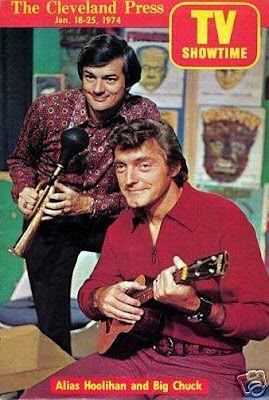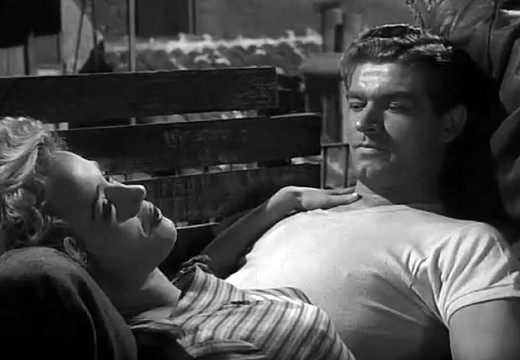So here I am, 10 years after clicking the “Publish” button for the first time on this site, and I’m still writing about my creaky old movies. Admittedly, I went on some extended hiatuses here and there to clear my head and keep the blog from becoming a rote thing I did out of habit instead of affection. But I’m happy that I kept going with it and I’m proud of some of the writing I’ve done on the site (and on occasion, other people’s blogs). As long as I continue to have fun, I'll keep at it.
 |
| Some days it feels like I started blogging in the era of newsreels. |
This being the Thanksgiving season, I thought I would devote this post to all the B-movie-related things for which I’m thankful. First, I’m thankful that I’ve had the time, opportunity, and technology to share my sketchy tastes in movies with a wider audience than just my ever-suffering family and friends. Over the years, I’ve also extended my musings to Facebook, Twitter, YouTube, and most recently, Instagram. It’s all in good fun, and so far (knock on wood) I’ve not allowed the social media blob to absorb all of my time and energy.
And, not to get too mushy or anything, but if you’re reading this and you’re not a bot, I’m very grateful for your attention. There’s a limitless universe of options out there, and that you took a moment or two to stop by means a lot. Uh-oh, I’m starting to tear up. Better get on with it...
The Top 10 B-movie-related Things I’m Thankful For
Darby O’Gill and the Little People
My earliest movie memory is getting into my pajamas (so I’d be ready for bed when we got home) and jumping into the car to go see Disney’s Darby O’Gill and the Little People (1959) at the drive-in.
Little did my parents suspect that a Disney kids’ movie would feature the scariest thing I’d seen yet in my young life -- the wailing, spectral banshee that shows up towards the end of the film. When the banshee appeared, I ducked down under the dashboard, shut my eyes and clapped my hands over my ears. Little did I or my parents know at the time, but instead of putting me off ghosts and monsters forever, that early shot of adrenaline hooked me on scary stuff for life.
For another account of a memorable drive-in experience, see my post on Castle of Blood.
 |
| When the banshee wails, your bladder fails. |
Gravesend Manor
A few years later, I was able to feed my scary movie addiction via Gravesend Manor, central Iowa’s hosted horror movie show (circa the mid ‘60s) that boasted a great ensemble cast of Malcolm the butler, The Duke, Claude and Esmeralda. The show was broadcast Saturday nights after the local news, and was my introduction to the classic Universal monsters, among other frightful fare.
A classmate’s father worked at the local TV station, and he got me a signed photo of Malcolm, The Duke and Esmarelda, a treasure that I still have to this day.
For more on Gravesend Manor and a clip from the show, see my review of Secret of the Blue Room.
 |
| Saturday nights at Gravesend Manor. Oh the horror... the horror! |
Hoolihan and Big Chuck
Eventually we moved and I had to say goodbye to my beloved Gravesend Manor. Fortunately, a new late night show with an off-the-wall cast filled the hole in my monster-loving heart.
From 1966 to 1979, The Hoolihan and Big Chuck Show featured Bob “Hoolihan” Wells (a former TV weatherman) and “Big” Chuck Schodowski introducing cheesy movies and performing even cheesier skits on Friday nights for WJKW-TV in Cleveland, Ohio.
They made constant fun of Parma, Ohio (much like Svengoolie’s affectionate jabs at Berwyn), and did parodies of such shows as Ben Casey (aka Ben Crazy).
It was at this point that my “late to bed, late to rise” lifestyle was cemented. Sure, my grades suffered, but the knowledge of horror and sci-fi movie trivia that I gained was well worth it.
For more reminiscences of late night horror hosts and their shows, see my post on "Shocking Scenes from ‘50s Sci-fi".
 |
| Be prepared to cover your ears! |
Universal Monster Rallies
Staying up way past my bedtime to see a scary movie was exciting enough, but it was an extra-special treat when the Gravesend Manor crew or Hoolihan and Big Chuck introduced one of the Universal monster “rally” pictures from the mid to late ‘40s.
Kids are generally not into the “less is more” philosophy, and I was no exception. I loved Frankenstein Meets the Wolfman, and I was in kid heaven when House of Frankenstein threw Dracula into the mix. And lo, these many years later, Abbott and Costello Meet Frankenstein is still a perennial Halloween favorite at my house.
For The Great Imaginary Film Blogathon back in 2013, I contributed a post on “What Might Have Been: The Universal Monster Rally You Never Saw.”
Karloff and Lugosi
Related to the monster rallies and the “more is more” philosophy, the pairing of two (or more) horror legends in the same movie was always something to keep an eye out for when browsing the TV guide. The first time I saw Boris and Bela together was probably in The Black Cat (or it could have been The Raven).
As a kid, it was enough just to see the two greats together in one film. After repeated viewings, The Black Cat (1934) stands out as one of the greatest dark, subtly depraved psychological horror films of all time. Fortunately, I completely missed the subtexts in the first few viewings, so I wasn’t too scarred from it.
Back in 2016 I wrote about The Black Cat for the “5 Movies on an Island” blogathon. See also descriptions of Karloff and Lugosi as mad scientists in “The Best Laid Plans of Not-so-nice Madmen”.
 |
| "Are you still fuming over not getting the Frankenstein role?" |
Cushing and Lee
While we’re on the subject of legendary pairings, perhaps the greatest in all of horror movie history is Peter Cushing and Christopher Lee, which began with Hammer’s The Curse of Frankenstein in 1957.
With his imposing physical stature, Lee would portray three of the classic monsters for Hammer, the Frankenstein monster, Dracula and the Mummy, while Cushing had a lot of work to do alternating between chasing down vampires as Van Helsing and scrambling for body parts as Baron Frankenstein.
I discovered the Hammer films a bit later in junior high, and their combination of technicolor blood and heaving bosoms was just the right fit for the new adolescent me.
For a “revisionist” take on a Cushing and Lee collaboration that doesn’t get a lot of love from fans, see my review of Dracula 1972 A.D.
 |
| "Hey Christopher, let me treat you to a stake after we call it a wrap." |
Hammer scream queens
During my adolescence, I kept falling in love/lust with the leading lady of each new Hammer film I saw. First it was Hazel Court from The Curse of Frankenstein, then Yvonne Furneaux from The Mummy, and Veronica Carlson from Dracula Has Risen from the Grave and Barbara Shelley from The Gorgon and Martine Beswick from Dr. Jekyll and Sister Hyde and… you get the picture.
My biggest cartoon-style eye-popping double-take came when I first saw Caroline Munro in The Golden Voyage of Sinbad (yes I know, not a Hammer film). Not surprisingly, around the same time period she was causing eyeballs to pop via such Hammer productions as Dracula A.D. 1972 and Captain Kronos: Vampire Hunter.
In the summer of 2019 I attended Creepy Classics’ Monster Bash conference in Mars, PA, which featured the premiere of House of Gorgon, independent filmmaker Joshua Kennedy’s low-budget love letter to the classic Hammer horror films. The film starred Caroline Munro, Veronica Carlson, Martine Beswick and Christopher Neame (Johnny Alucard in Dracula 1972 A.D.). Veronica and Martine, both exceedingly glamorous and gracious, were on hand to meet fans and talk about the film and their careers (as was Christopher, who related some amusing stories about filming Dracula; Caroline unfortunately was not able to attend). Read all about it here.
 |
| Veronica Carlson and Martine Beswick at their Monster Bash Q&As. |
Roger Corman
Besides the Universal and Hammer horrors, a mainstay of all those late night shows were the audaciously cheap films of the King of the B’s, Roger Corman. Corman was a genius at filming as quickly and cheaply as possible: getting freebies from local businesses, reusing locations and sets, and calling on a stable of actors who were ready to go at a moment’s notice.
Over the years, Corman’s early sci-fi quickies have become beloved nostalgic icons: A Bucket of Blood, The Little Shop of Horrors, Not of This Earth, Attack of the Crab Monsters -- every fan has his/her favorite. The combination of bent humor and shocking scenes that snuck up on you was like nothing else coming out of the ‘50s and ‘60s.
But Roger’s greatest contribution is the long list of Hollywood luminaries who got their starts working on his nothing-budget pictures: Francis Ford Coppola, Ron Howard, Martin Scorcese, Jack Nicholson, and James Cameron, to name just a few.
For the blog’s third anniversary, I reviewed a “Roger Corman Sci-fi Triple Feature” DVD set.
Vincent Price
If the only horror movies Vincent Price had ever made were just the Poe adaptations directed by Roger Corman, he would still rank among the all-time horror greats.
But fortunately, he lent his sinister sophistication to a whole slew of horror vehicles. Price was an avid art collector, connoisseur and gourmet cook when he wasn't in front of the cameras. His horror roles were a sort of funhouse mirror reflection of his real-life interests. He was a sculptor in House of Wax, a nobleman in The Masque of the Red Death, a doctor in The Abominable Dr. Phibes and a Shakespearean actor in Theater of Blood. He may have been mad as a hatter in most of those roles, but he was always smooth and refined to a fault.
Back in January, I wrote about Price’s singular life and career and one of his lesser known, underrated films, Diary of a Madman.
 |
| Vincent Price life lesson #1: Beware of mad sculptors bearing gifts. |
Val Lewton
Like Roger Corman, producer Val Lewton had a gift for making successful low-budget movies while mentoring talented novices. The list of graduates of Lewton’s “on the job” film school rivals Corman’s, with such distinguished directors as Mark Robson, Jacques Tourneur and Robert Wise having learned their craft directing such budget classics as Cat People, I Walked with a Zombie, The Body Snatcher, and The Seventh Victim.
But where Corman’s films were in-your-face cheesy and exploitive (and lucrative), Lewton’s B’s were understated, atmospheric and cerebral (and more popular with critics). There is a time and a place for both approaches, but today’s low-budget horror filmmakers could especially benefit from taking a page or two from Lewton’s less-is-more, what-you-don’t-see-can-be-scarier-than-what-you-do-see book.
See my post on Lewton protege Jacques Tourneur’s greatest horror film, Curse of the Demon.
 |
| The Body Snatcher (1945) was Lewton's 9th credit as a producer. |
To wrap things up, I hereby bestow upon myself this beautiful certificate, suitable for framing, recognizing 10 selfless years of service to the blogging community. Congratulations!








